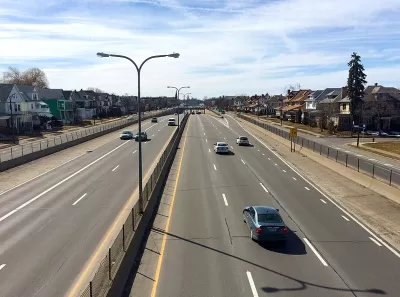State and local officials say the $1 billion project will heal neighborhoods divided by the Kensington Expressway, but community members say the proposed plan will exacerbate already poor air quality in the area.

When it was built in the 1950s, the Kensington Expressway cleaved neighborhoods on the East Side of Buffalo, New York, apart and led to air quality-related health concerns for nearby residents. A new $1 billion project funded by the Bipartisan Infrastructure Law proposes to sink a three-quarter mile section of the highway and cap it with a park to reconnect the neighborhoods and restore a historic boulevard. But some locals are fighting it, saying it will only make the pollution worse, reports Benjamin Schneider in a Bloomberg CityLab article. The project’s environmental assessment projected that car exhaust pushed out either end of the tunnel by the airflow caused by the moving vehicles “would increase pollution levels by about 6% over current conditions in the areas immediately adjacent to the tunnel entrances, even as air quality would improve slightly on the cap itself,” Schneider writes.
According to Schneider, “the debate underscores the challenges facing the US Department of Transportation’s Reconnecting Communities program … that’s designed to redress the harms of urban highways built across predominantly Black neighborhoods during the 1950s and ’60s. Some of the biggest and most costly projects being funded by the program are freeway caps — a popular strategy for knitting neighborhoods back together without reducing the volume of vehicles or the emissions they produce.” He reports that Philadelphia, Atlanta, and Austin are considering using funding from the federal infrastructure act program for freeway caps.
The project is one of many of a growing “cap and cover” movement that state and local governments are hopping aboard, as reported by the Daily Beast. But questions about the long-term implications of these projects remain. A Colorado Public Radio News article about Denver’s new 4-acre cap park above I-70 that opened last year states, “Air quality concerns are only one reason anti-highway activists now see Denver’s park as a cautionary tale.” Among others are fears that the new public green space and park amenities will spur gentrification and displacement of existing community members.
FULL STORY: A Highway Cap Divides the City It Was Designed to Reconnect

Study: Maui’s Plan to Convert Vacation Rentals to Long-Term Housing Could Cause Nearly $1 Billion Economic Loss
The plan would reduce visitor accommodation by 25,% resulting in 1,900 jobs lost.

North Texas Transit Leaders Tout Benefits of TOD for Growing Region
At a summit focused on transit-oriented development, policymakers discussed how North Texas’ expanded light rail system can serve as a tool for economic growth.

Why Should We Subsidize Public Transportation?
Many public transit agencies face financial stress due to rising costs, declining fare revenue, and declining subsidies. Transit advocates must provide a strong business case for increasing public transit funding.

How to Make US Trains Faster
Changes to boarding platforms and a switch to electric trains could improve U.S. passenger rail service without the added cost of high-speed rail.

Columbia’s Revitalized ‘Loop’ Is a Hub for Local Entrepreneurs
A focus on small businesses is helping a commercial corridor in Columbia, Missouri thrive.

Invasive Insect Threatens Minnesota’s Ash Forests
The Emerald Ash Borer is a rapidly spreading invasive pest threatening Minnesota’s ash trees, and homeowners are encouraged to plant diverse replacement species, avoid moving ash firewood, and monitor for signs of infestation.
Urban Design for Planners 1: Software Tools
This six-course series explores essential urban design concepts using open source software and equips planners with the tools they need to participate fully in the urban design process.
Planning for Universal Design
Learn the tools for implementing Universal Design in planning regulations.
City of Santa Clarita
Ascent Environmental
Institute for Housing and Urban Development Studies (IHS)
City of Grandview
Harvard GSD Executive Education
Toledo-Lucas County Plan Commissions
Salt Lake City
NYU Wagner Graduate School of Public Service





























